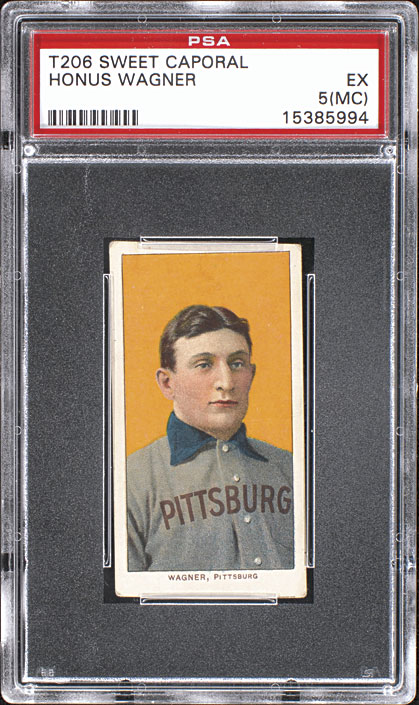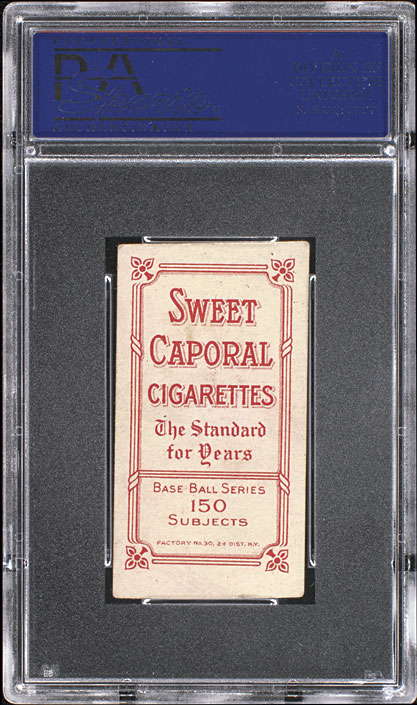T206 Honus Wagner PSA-5 -- The Magnificent "Jumbo" Example
Mastro Auctions (Aug. 1, 2008)
Mastro Auctions presents a T206 Honus Wagner PSA-5 - One of the Finest in Our Hobby: The Magnificent "Jumbo" Example
in their Aug 2008 live auction. Bidding opens on Monday July 21, 2008 at 10:00 AM Central Time.


The following is the auction description:
To quote celebrity auctioneer Robert Woolley: "...and now...the Holy Grail!"
The intonation of those words from a regal podium nearly twenty years ago marked the culmination of an
unprecedented series of events. Before the "Holy Grail" was announced in this fashion, an incredible awakening
had taken place in the auction industry. A genteel, established concern's generally staid environment had been
placed into the glare of publicity from new, entirely unexpected quarters. The hushed tones of a few well-heeled
individuals murmuring about the merits of a fine, artistic work were suddenly drowned out by a clamor, as a horde
of photographers rushed for the right shot and bunches of reporters sought the appropriate quote. Breathless with
anticipation, too, was the audience, as those people who were physically on site to participate became the envy of
throngs spread remotely across the land. The "Grail" had arrived, and the culture—of auctions, of collecting, and,
indeed, a facet of human longing—was destined to be changed forever.
It's not typical for there to be an undisputed consensus in any field of collecting—whether it be among
enthusiasts of Fine Arts, seekers of the world's most valuable coins, or those who cherish vintage musical
instruments—with respect to the identity of the single, very best piece in a particular specialty. That is
to say, the experts usually fail to agree. In the forum of vox populi, however, universal acclaim falls naturally
and easily at the feet of specific, high-profile and mystique-filled objects. Thus, even the uninitiated will
speak in awe about the Mona Lisa, the barely literate recognize that the Brasher Doubloon was once intended to
be spent, and the most tone-deaf soul on earth understands the meaning of the Stradivarius. It's in this vein of
subliminal knowledge that virtually everyone in America—from soccer mom to sophisticate, from pedestrian to
patrician—instantly equates the name "Honus Wagner" with the concept of the baseball card hobby's summum bonum—"highest
good." In a manner comparable to stamp collecting's "upside-down airplane"/Inverted Jenny, comicdom's "Action #1,"
the political realm's Cox/Roosevelt jugate pinback, and automobilia's Gull-Wing Mercedes, Honus Wagner enjoys fully
iconic status. This entry stands alone above all other baseball cards in stature, value, recognizability, and
desirability, and it represents the very heart and soul of the entire baseball card collecting world.
Wagner's ascent to embody the pinnacle achievement within an entire industry is a relatively recent occurrence:
the commotion attendant to the sale of one specimen by a venerable auction-holding establishment—and that house's
befuddlement in attempting to channel the unexpected intensity of interest in its own offering!—is testament to
that. The card's tradition is nonetheless a strong and storied one, and its role has matured to a degree such that
a vast—and fully informed—audience observes, assesses, and participates whenever the Holy Grail changes hands.
Presented is a demonstrably spectacular example of the 1909 T206 White Border Honus Wagner tobacco card. Due
to its generous top and bottom borders—which are unprecedented in scope and frame the prized central image of
Wagner within a virtual sea of bright white—the piece merits a unique appelation: the "Jumbo" Wagner. This
treasured collectible's distinctive, large-size attribute, in combination with its sublime illustration and
its praiseworthy state of preservation throughout, dictates that the offered piece stands as the 5th-, 6th-,
or 7th- best of its kind known to exist.
The foregoing claim relies on a body of scholarship that's too comprehensive to be recounted in a single
description (though a sidebar is provided to substantiate it). The matter of the "Jumbo" Wagner's sizing,
however, holds such importance that additional illumination of this property can prove instructive. In general,
"Jumbo" examples are seen within the stamp collecting hobby, and they're rare and much-prized by advanced
philatelists. Routine items that enjoy outsized dimensions become coveted "rarities" on the strength of that
quality alone, and their allure increases exponentially when a subject's preordained, inherent "rarity" is
added to the mix. "Jumbo's" are hobby elites, and their scarcity is inevitably complemented by enhanced aesthetic
appeal—with both aspects symbiotically reinforced, as in the case of the "Jumbo" Wagner, by premium dimensions.
Graded EX 5 (MC) by PSA. The mere sight of a T206 Wagner is sufficient to provoke an unbelievably pleasant
sensation—unique to each individual—within the emotional core of a baseball enthusiast, and the "Jumbo" Wagner's
effects are especially compelling. Above all, it must be noted that its "Jumbo" boundaries—1-7/16" x 2-11/16"—serve,
in a very real sense, as guardians of a NM/MT to MT card inside. Within such a lofty, but logical context, the piece's
mild corner wear becomes a non-issue. And, the whisper of a once-adjacent depiction's frameline at the "Jumbo" Wagner's
bottom edge (the aspect that occasioned PSA's qualifier) assumes the role of "distinguishing mark." (Here, it's
certainly not a "fault.") To address the "Jumbo" Wagner's more overt features: the observer sees at once that Wagner's
gaze has remained solid and direct, and that its orange surround has lost none of its purity. Almost a century's-worth
of existence has not jeopardized the card's inking—front or back—and the holistic effect of its presence is nothing
less than spellbinding.
Here—in its one-of-a-kind "Jumbo" incarnation—is the item that has inspired the industry from its earliest days.
This is the artifact that continues to be the ultimate goal of every enthusiast, and which singlehandedly acts as
a figurehead for our hobby in the estimation of the masses. Honus Wagner's presence elevates any collection like
no other force on the planet, but so lamentably few of the avocation's finest assemblies have the opportunity to
attain the resultant, ultra-elite status thus afforded. This special card, with faint signs of natural handling and
admiration displayed proudly and its unique manners of character and size showcased boldly, represents the cherished
essence of the innumerable, rewarding lifetimes spent in pursuit of collecting fulfillment.
The "Holy Grail" - An Explanation of Hierarchy
Following is a listing of prominent T206 Wagner examples, with grades and respective paths of provenance noted:
(Clearly) #1 - Mastro --> Copeland --> "Gretzky" --> Gidwitz/Lifson --> Seigel --> Private Investor - PSA NM-MT 8
(the first graded by PSA);
(Clearly) #2 - Lipset --> Mastro --> Halper --> Baseball Hall of Fame (it's now displayed at Cooperstown) - although
not professionally graded, the card would probably grade 6 to 6.5 (borderline Near Mint), and is oversized;
#3 - Richard Gelman --> Corey Shanus - not professionally graded, conservatively EX+, with stronger corners than the
confirmed EX examples;
#4, #5?, #6? - these three specimens emerged from a non-collector (August Jacobs of West Babylon, NY, now deceased)
during the early 1970s - all were in similar condition at EX or close to EX - within this group, sold by the Jacobs
family:
a) - Leland's --> Mastro --> Scott Ireland - PSA EX 5 (by virtue of its "straight 5" grade, this example is
technically better than the "Jumbo")
b) - Mastro --> Dr. Robert Goode --> Mark Macrae - EX
c) - Larry Fritsch (now deceased) - EX
#5?, #6?, #7? - The "Jumbo" Wagner - PSA EX 5 (MC) - The "Jumbo" is likely better than the Fritsch or Macrae
copies (neither of those are professionally graded) and is absolutely better than the Burdick specimen.
#8 - Burdick example - housed at the Metropolitan Museum of Art, New York City, since the late 1950s - the card
has an EX obverse, and is still adhered to an album page (making the reverse naturally suspect).
No specimens known or seen to date compare in terms of condition to the eight cards listed, although a few of the
hobby's VG or VG/EX examples might supplant Burdick's in the ranking (if that card does, in fact, have back damage).
Estimated Value: $500,000 - $750,000.
Final Bid with Buyer's Premium: $1,620,000
RELATED ARTICLES:
Periodical - Arkansas man buys Wagner baseball card for $1.62M
|